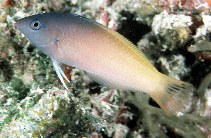| Family: |
Labridae (Wrasses), subfamily: Corinae |
| Max. size: |
13 cm SL (male/unsexed) |
| Environment: |
reef-associated; marine; depth range 2 - 40 m |
| Distribution: |
Western Pacific: east to Samoa (Ref. 27362) and Tonga (Ref. 53797). |
| Diagnosis: |
Dorsal spines (total): 9-9; Dorsal soft rays (total): 12-13; Anal spines: 3-3; Anal soft rays: 12-12; Vertebrae: 25-25. Anterior head and body color of adults in life bluish gray, shading posteriorly to yellowish; scales often with orange-yellow vertical lines; a dark spot posterior to dorsal half of eye; dorsal fin with a large black spot edged with blue. Anterior lateral line scales with 1-3 pores; 9-11 suborbital pores. Anterior dorsal and anal soft rays longer than posterior rays; pelvic fins of males and large females very long, reaching posterior to anus, often to or beyond origin of anal fin. Juveniles with 4 black stripes on head and body. |
| Biology: |
Inhabits lagoon and seaward reefs, in coral-rich areas (Ref. 9710). Also found along drop-offs on the bottom of large caves. Usually seen solitary (Ref. 48636). |
| IUCN Red List Status: |
Least Concern (LC); Date assessed: 25 March 2009 Ref. (130435)
|
| Threat to humans: |
harmless |
Source and more info: www.fishbase.org. For personal, classroom, and other internal use only. Not for publication.

